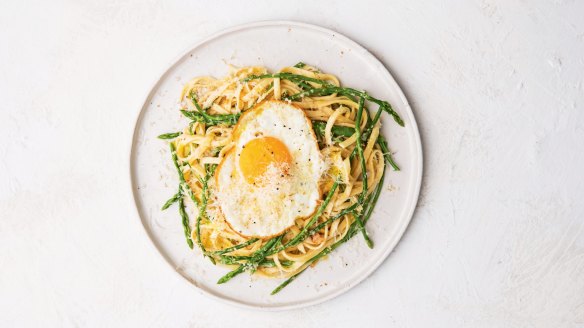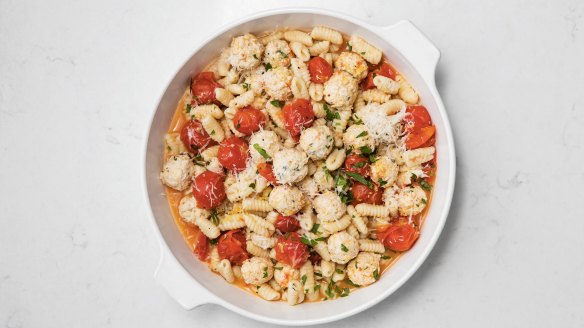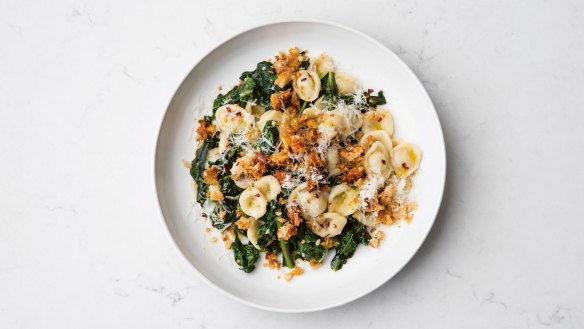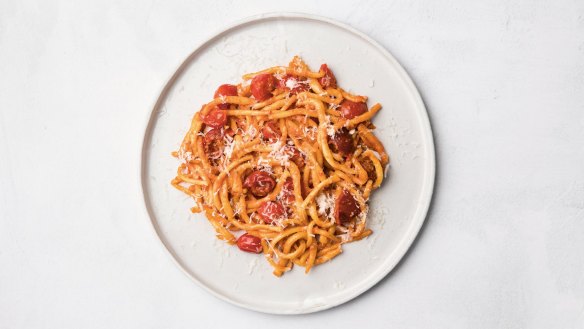Four recipes from Elizabeth Hewson's new cookbook Saturday Night Pasta

Making pasta is akin to meditation, Elizabeth Hewson believes. Comforting, pressure-free and reaffirming, the humble act of making fresh linguine, strozzapreti or tagliatelle from scratch is therapy for the modern-day food lover, she says, teaching self-care through flour and water.
"Like the practice of meditation, making pasta by hand is a way of achieving self-discovery and mindfulness ... with delicious results," the PR consultant and cookbook author says.

Hewson's new cookbook, Saturday Night Pasta, includes 40 recipes, including dried pasta substitutes for the time poor, plus step-by-step guides to different pasta shapes and trouble-shooting tips.
Here are four dishes to make at home and enjoy.
Asparagus, fried egg, brown butter, walnut
This dish is best enjoyed in asparagus season, which means spring, thank you very much (don't be fooled by the expensive Peruvian or Mexican imported versions that sit on supermarket shelves year round). I prefer the thin, almost wild-looking asparagus that bends with the noodle. If you only have thick spears, you can shave them to achieve a similar result, but that is, of course, optional. For those who have not had the pleasure of tasting walnut oil, it's a revelation, giving a tender kiss of walnut to your dish without the occasional bitterness of the raw nut.
INGREDIENTS
- 1 bunch of asparagus – choose thin spears over fat spears if you can
- 2 tbsp salted butter
- 1 tsp extra-virgin olive oil
- 2 eggs
- 2 tbsp walnut oil
- handful of grated parmigiano reggiano, plus extra to serve
- sea salt and freshly ground black pepper
- 2 walnuts, to serve (optional)
- fresh pasta for 2 or dried pasta for 2 (linguine, spaghetti)
METHOD
- Bring a large saucepan of water to a lively boil and season as salty as the sea.
- Snap the ends off the asparagus (they will naturally break where the stem goes from tender to woody). Discard the woody ends.
- Add the asparagus to the boiling water and blanch for 1 minute until just tender – did you notice how I said blanch? Do not commit the heinous crime of overcooking your asparagus. The spears should be bright green, strong and crisp, not floppy and limp. Pluck out the asparagus and refresh under cold running water. Set aside.
- Cook your pasta in the same boiling water until al dente.
- Melt the butter in a frying pan, along with the olive oil to stop it burning, until it starts to brown. Add the eggs and fry, sunnyside up, for 2 minutes. The whites need to be cooked, but the yolks should be just set.
- Reserve 250ml (1 cup) of the pasta cooking water, then drain the pasta and return it to the saucepan, along with the asparagus, walnut oil and parmigiano reggiano. Season with salt and pepper, then add 125ml (½ cup) of the cooking water and give everything a strong swirl. Add a little more cooking water if you feel it's needed.
- Divide the pasta between bowls and top with the fried eggs, burnt butter from the pan and extra parmigiano reggiano. Finely grate over the walnuts, if using, and serve immediately. Pasta waits for no one.
Serves 2

Chicken meatballs, tomato and lemon broth
Yes this does require a few steps – make the meatballs, boil the meatballs, then bring it all together in a crazy flavour-packed broth – but it's all simple, pleasurable work that fits in nicely with the SNP concept. These chicken meatballs are lovely and springy, helped along by the fact that they're boiled rather than fried. Sometimes I serve them over a can of drained cannellini beans and greens for a non-pasta meal.
INGREDIENTS
- 500-700ml chicken stock
- 2 tbsp extra-virgin olive oil, plus extra for drizzling
- 2 garlic cloves, finely chopped
- 1 bird's eye chilli, roughly chopped (use half if you prefer less heat)
- 250g cherry tomatoes
- 125ml (½ cup) dry white wine
- zest of 1 lemon
- 30g (1 cup) flat-leaf parsley leaves, roughly chopped
Chicken meatballs
- 500g chicken mince
- 80g (1 cup) finely grated parmigiano reggiano, plus extra to serve
- 1 small egg, lightly beaten
- 1 tbsp thyme leaves
- zest of 1 lemon
- fresh pasta for 4 or dried pasta for 4 (risoni, ditalini, cavatelli or any small-shaped pasta)
METHOD
- To make the chicken meatballs, combine the chicken mince, parmigiano reggiano, egg, thyme, lemon zest and a generous pinch of salt and pepper in a bowl. Squish everything together with your hands to combine well. Using a teaspoon as a guide, roll the mixture into bite-sized meatballs, keeping your hands wet to avoid the mixture sticking as you roll. Patience is key here. Take your time to keep all the meatballs small and roughly the same size, as they pair better with the pasta. The meatballs can be kept in the fridge for up to 3 days.
- Bring the stock to a gentle simmer in a saucepan over medium heat. Working in batches, add the meatballs and poach for 5 minutes or until they float to the surface like little buoys. Remove with a slotted spoon and set aside, reserving the stock.
- Place a deep frying pan over medium heat and add the olive oil, garlic and chilli. Saute for 1 minute or until fragrant, but not brown. Add the cherry tomatoes and saute for a further minute.
- Pour in the wine and cook for 5 minutes or until it starts to bubble away. Add about 300ml of the reserved chicken stock and cook for 10 minutes or until the tomatoes are soft. Season with salt and pepper.
- Meanwhile, bring a large saucepan of water to a lively boil and season as salty as the sea. Add the pasta and cook until al dente, then drain.
- Add the meatballs to the sauce, along with the cooked pasta and the lemon zest and toss everything together.
- Divide the pasta among bowls and serve with a good drizzle of olive oil, the parsley and a grating of parmigiano reggiano.
Serves 4

Bitter greens, chilli, pork crackling
The best part of a pork roast is the crackling, so it's only right that there is a pasta dish to celebrate this. Of course, the Italians have already created such a dish in the form of a stuffed pasta with bitter greens that gets tossed through a topping of chilli and pork crackling. The dish hails from Puglia – the region best known for its deeply rooted "cucina povera" traditions. This means that the cuisine tends to be simple, cheap and makes use of absolutely everything, including pig skin. In fact, it could be argued that some of the most famous (and delicious) meals were invented by people who were short on time, money and resources, making the most of the ingredients available. This dish is no different: simple, affordable and full of flavour. You can pick up pig skin from your local butcher or direct from market stall-holders for about $2. Cime di rapa, also known as broccoli rabe, is a bitter green that comes into season in autumn. If you can't find it, which I admit can be difficult if you don't have access to a farmers' market, cavolo nero, chicory, spinach, rainbow chard or kale leaves work just as well. And like the thrifty Italians, if you have some radishes you could also throw in the tops with the greens, which adds a further layer of bitterness and makes use of the whole ingredient.
INGREDIENTS
- 250-300g piece of pork skin
- 2 tbsp extra-virgin olive oil
- 2 tsp sea salt
- 1 tsp chilli flakes
- ½ tsp fennel seeds
- 2 garlic cloves, chopped
- 1 bunch of cime di rapa, cavolo nero, chicory, spinach, rainbow chard or kale, leaves stripped and roughly chopped
- large handful of grated parmigiano reggiano, plus extra to serve zest of 1 lemon
- fresh pasta for 4 or dried pasta for 4 (gnocchetti sardi, rigatoni)
METHOD
- Preheat the oven to 220C fan-forced (240C conventional).
- Using a sharp knife, score the pork skin vertically at 5mm intervals. This helps the heat of the oven and the salt work their way through the skin, drying out the moisture and making your crackling really crisp.
- Rub 1 tablespoon of the olive oil, the salt, ½ teaspoon of the chilli flakes and the fennel seeds all over the pork skin and place on a wire rack over a baking tray (this allows the fat to drip down off the skin as opposed to the skin sitting in its own fat). Roast for 45 minutes, then carefully turn the pork skin over and roast for a further 10-15 minutes, until bubbles appear and the crackling is golden and crisp.
- If you're like me, resist the urge to nibble the crackling and leave it to cool for at least 5 minutes before cutting up into small shards ready for sprinkling. Now you can enjoy a small piece – the cook's treat – I won't tell.
- Bring a large saucepan of water to a lively boil and season as salty as the sea. Add the pasta and cook until al dente.
- Meanwhile, heat the remaining 1 tablespoon of olive oil in a frying pan over medium heat. Add the remaining chilli flakes and the garlic and cook for 30 seconds or until the garlic just starts to soften, but not brown. Throw in the greens and toss to coat until wilted.
- Add the pasta directly to the greens, along with a 125ml (½ cup) of the cooking water. Add the parmigiano reggiano and lemon zest and give everything a good toss, adding a little extra cooking water if needed to loosen things up.
- Divide the pasta among bowls and rain over the pork crackling. Be generous. Sprinkle with extra parmigiano reggiano and serve.
Serves 4

'Nduja, cherry tomatoes, preserved lemon
I first came across 'nduja high up in the hills of Calabria. We were visiting Rossano, a tiny historic town off the tourist track. As we walked around, I noticed that outside every shop front the owner would proudly sit and beckon you in with, "I make the best (insert product they were selling)". When we went up to the butcher, he lured us in with tastings of his famed 'nduja salami. The spreadable spicy salami, made bright red from fiery Calabrian peppers, was the first time I had really tasted heat in Italy – aside from Calabria, most Italians prefer to keep things on the mild side – but it was perfectly balanced by the pork fat and the other flavours. Sure, it was the first time I had tasted 'nduja and I happened to be in its birthplace, but the butcher was right, and to this day I've never eaten better. What I took away from that hillside town was not only a huge piece of 'nduja, which melted into every dish I cooked over the following days, but an appreciation of the pride and confidence Italians have in themselves and their creations. I think we could all do with a little of that Italian pride. There are very few ingredients in this sauce, which is brought together by the starchy cooking water. The 'nduja is there to add flavour, while the other ingredients balance out the heat. If your 'nduja is particularly hot (always taste it first), balance it out with more mascarpone. Between the salted cooking water, 'nduja and preserved lemon, you shouldn't need to add any more salt. If you don't have preserved lemon, replace it with a squeeze of lemon juice, a little lemon zest and pinch of salt.
INGREDIENTS
- 70g 'nduja
- 250g cherry tomatoes, halved
- 2 tbsp mascarpone
- 1 preserved lemon quarter, skin only, finely sliced
- 25g (1⁄₃ cup) grated parmigiano reggiano, plus extra to serve
- fresh pasta for 2 or dried pasta for 2 (bucatini, linguine, rigatoni)
METHOD
- Bring a large saucepan of water to a lively boil and season as salty as the sea. Add the pasta and cook until al dente.
- Place a large frying pan over medium heat. Squeeze out the 'nduja into the pan and use the back of a wooden spoon to stir and encourage it to gently melt into a fiery red sauce. Stir the tomato through the melted 'nduja and continue to cook for 10 minutes, until the tomato is soft and starting to give up some of its juice.
- Drain the pasta, reserving 250ml (1 cup) of the cooking water. Toss the pasta through the sauce, along with the mascarpone, preserved lemon, about 80 ml (1⁄3 cup) of the cooking water and the parmigiano reggiano. Give everything a forceful stir to encourage the sauce to emulsify, adding extra cooking water if needed.
- Divide between bowls and serve with extra parmigiano reggiano.
Serves 2
Edited extract from Saturday Night Pasta by Elizabeth Hewson, published by Plum, RRP $36.99. Photography by Nikki To. Buy now